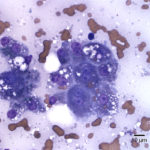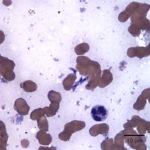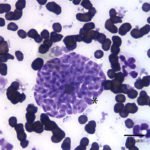Liver aspirate from a cat
Case information
An 11-year-old male castrated domestic longhair cat presented to the Cornell University Hospital for Animals (CUHA) Emergency Service for a five day history of lethargy, anorexia, persistent hyperthermia, and increased liver enzymes. The cat was first brought to the primary care veterinarian for a two day history of lethargy and inappetance. At that time, bloodwork revealed hypoproteinemia, hypoalbuminemia, and hypocholesterolemia. Radiographs of the chest and abdomen showed mild hepatomegaly. The cat was treated with subcutaneous fluids, antibiotics, and prednisone. After one week of treatment, no improvement was noted and the cat was brought to CUHA for further evaluation.
On presentation, the cat was bright, alert, and responsive, but was hyperthermic (104.8°F), tachycardic (210 bpm), and mildly dehydrated (5-7%). Physical examination also revealed mild icterus in both sclera and discomfort on cranial abdominal palpation. Blood was drawn for a CBC and chemistry panel. The CBC showed a mild normocytic normochromic nonregenerative anemia (hematocrit: 29%, reference interval [RI]: 31-48%). Results also showed a normal total leukocyte and neutrophil count with a mild left shift (0.2 thou/uL, RI: 0.0-0.1 thou/uL) and mild toxic change. Abnormal liver biochemical results are shown below:
| Analyte | Result | RI | Units |
| ALT | 1817 | 35-176 | U/L |
| AST | 2236 | 15-44 | U/L |
| ALP | 26 | 13-83 | U/L |
| GGT | <3 | 0-2 | U/L |
| Total bilirubin | 4.1 | 0-0.2 | mg/dL |
| Direct bilirubin | 2.9 | 0-0.1 | mg/dL |
| Indirect bilirubin | 1.2 | 0-0.2 | mg/dL |
An abdominal ultrasound examination revealed mild hepatomegaly, with rounding of the edges of the liver, and enlarged jejunal lymph nodes. Ultrasound-guided needle aspirates were taken from each site and samples were submitted for cytologic evaluation.
Examine the representative images of the liver aspirate that are provided below and answer the following questions:
- How would you interpret the biochemical results reported above?
- Based on the cytologic findings, what are your differential diagnoses for the underlying cause?
- What other diagnostic tests could be done in this case?
 |
 |
 |
Answers on next page
